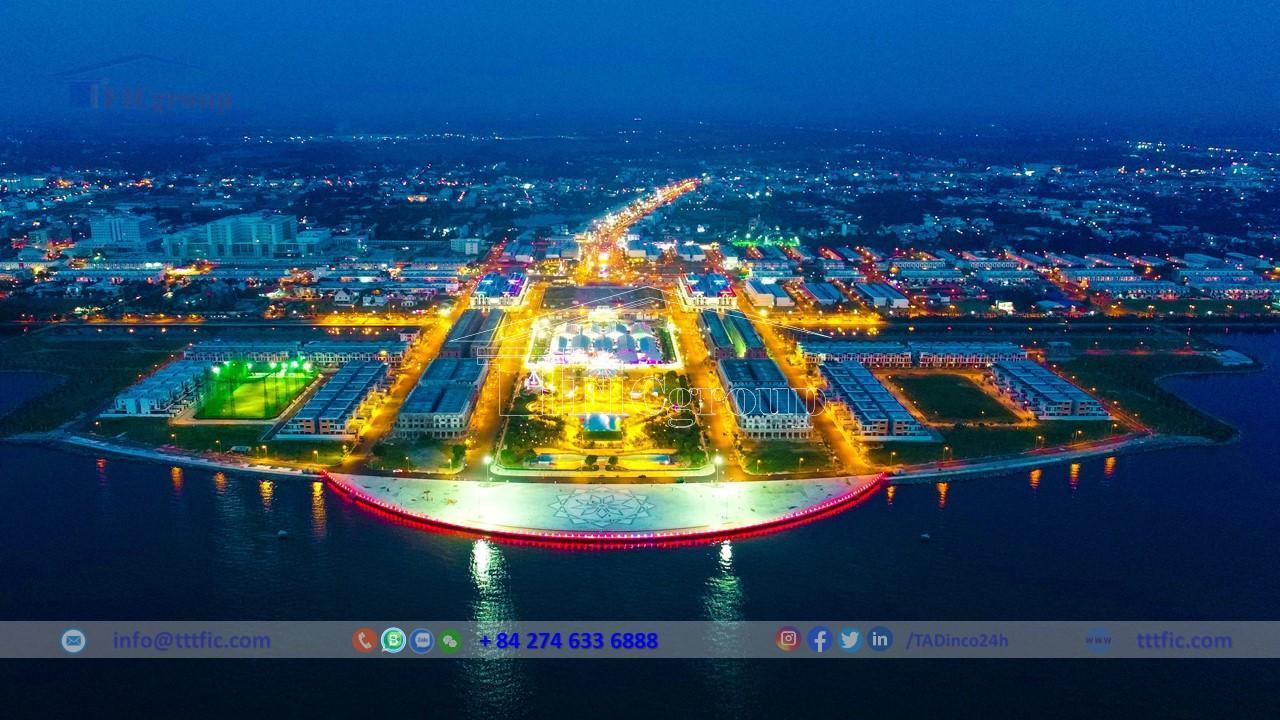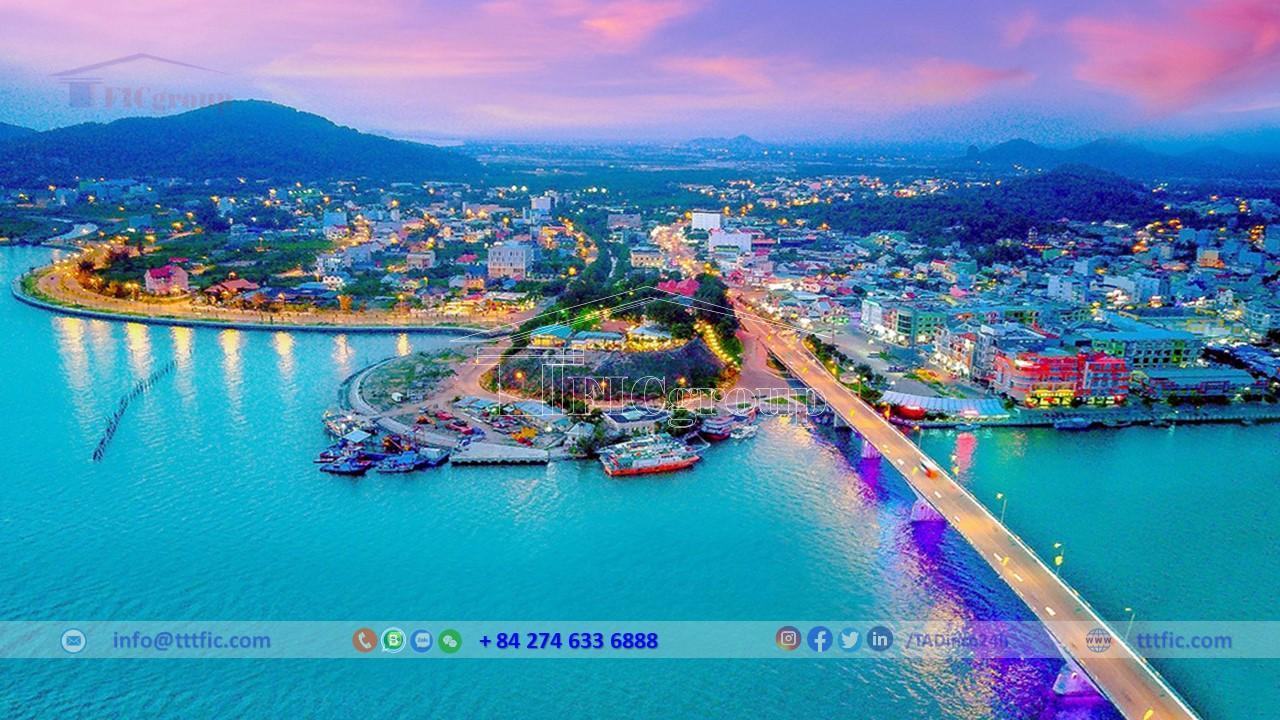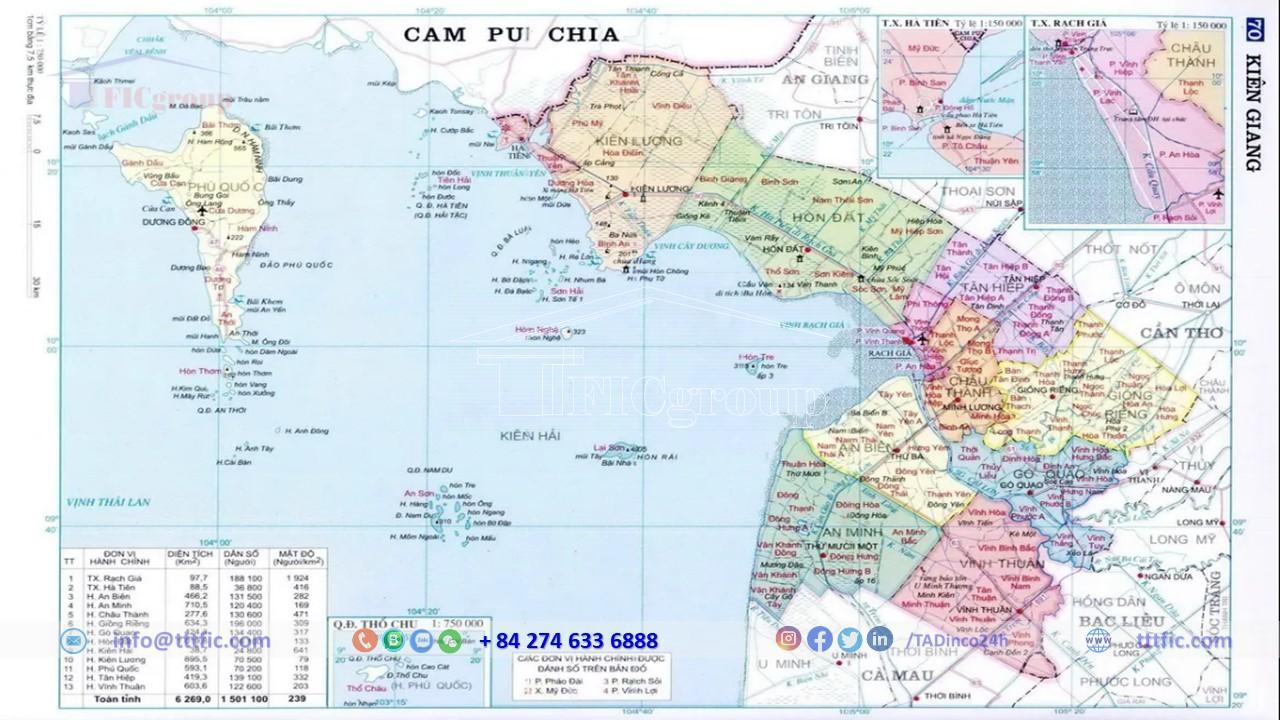Kien Giang Province:
Kien Giang province, a coastal province in the Mekong Delta region of Southern Vietnam, is characterized by its proximity to the Gulf of Thailand. It encompasses the city of Rạch Giá and the entire former province of Hà Tiên. With its expansive land area, Kiên Giang is the largest province in the Southwest region and the second largest in the South (after Bình Phước province). However, during the Nguyen Dynasty, the entire area of present-day Kiên Giang belonged to Hà Tiên province. The provincial capital is the city of Rạch Giá, located approximately 120 km from Cần Thơ and 250 km from Ho Chi Minh City. Kiên Giang is a significant economic hub within the Mekong Delta region.
In 2018, Kiên Giang ranked as the 11th most populous administrative unit in Vietnam, 19th in terms of Gross Regional Domestic Product (GRDP), 31st in per capita GRDP, and 39th in GRDP growth rate. With a population of 1,723,067 people, the GRDP reached 101,887.58 billion Vietnamese Dong (equivalent to 4.4 billion USD), the per capita GRDP was 58.13 million Vietnamese Dong (equivalent to 2,527 USD), and the GRDP growth rate for 2021 stood at 0.58%.
Geography:
Geographical location:
Kiên Giang, located in Vietnam’s southwest, comprises mainland and island territories. It shares a border with Cambodia’s Kampot province to the north, borders Cà Mau province to the south, the Gulf of Thailand to the west, and An Giang, Hậu Giang, Bạc Liêu, and Cần Thơ to the east.
The Gulf of Thailand hosts over 100 coastal islands, including Phú Quốc Island, the largest, and the Thổ Chu archipelago, consisting of five island groups.
Rạch Giá, the provincial capital, is situated 250 km west of Ho Chi Minh City. Kiên Giang has a 54 km border with Cambodia and over 200 km of coastline along the Gulf of Thailand. It is also home to more than 100 islands.
Originally part of the Hà Tiên territory, Kiên Giang was explored by General Mạc Cửu in the 17th century. It became one of Nam Kỳ’s provinces during Emperor Minh Mạng’s reign. Since 1975, Kiên Giang has been a separate province.
People know Kiên Giang for its rich culture and its popularity as a tourist destination in the Mekong Delta region. Attractions like Hòn Phụ Tử and Phú Quốc Island contribute to its fame. The province also has great economic potential in the fisheries sector. Rạch Giá, the provincial capital, is one of two coastal cities in the Mekong Delta.
Strategically located near Southeast Asian countries, Kiên Giang serves as a gateway connecting Vietnam’s southwestern provinces with its neighbors, fostering economic exchanges.
Natural condition:
Kiên Giang in Vietnam features diverse terrains like plains, mountains, and islands. The mainland area is mostly flat, sloping from northeast to southwest. Being in a low latitude coastal area, it experiences a tropical monsoon climate with warm temperatures year-round, averaging 27-27.5°C. Although hurricanes don’t hit directly, they contribute significantly to the annual rainfall, especially during the rainy season from April to November.
The four main regions divide the province: the sweet alluvial in the West of Hau River, the saline inundated in Long Xuyen Quadrangle, the salt-contaminated in Ca Mau Peninsula, and the mountainous and island areas in Phu Quoc and Kien Hai. Agricultural land accounts for 64.2% of the area, with forested land around 122.8 thousand ha. There is also 70 thousand ha of unstable land and over 25 thousand ha of mixed gardens. The province is rich in mineral resources, with 152 ore points and 23 different types of mines identified so far.

Economy:
In 2012, Kien Giang’s economic growth rate reached 11.81%, just below the 12.5% target. It ranked third in the Mekong Delta region after Hau Giang and Bac Lieu. The GDP per capita was $2026. Total grain output reached a record 4.28 million tons, leading the country for the second year. The province produced an estimated 548,182 tons of seafood, an increase of 8.24% from 2011.
In 2012, Kien Giang’s economy grew by 11.81%, third highest in the Mekong Delta region. The GDP per capita was $2026. Grain production reached a record 4.28 million tons. Aquaculture production was 548,182 tons, exceeding the target by 0.95%.
Industrial production value was about VND 16,055.3 trillion, retail sales and services were about VND 41,710 trillion, and exports were $620 million. Investment and trade promotion activities were enhanced, attracting effective resources for provincial development.
State budget revenue was about VND 4,406 trillion, state budget expenditure was about VND 8,357 trillion. Bank operations and working capital grew by 14.28%, and local mobilization increased by 20.59% compared to 2011. The Consumer Price Index increased by 6.3%.
Kien Giang, with a sea area of about 63,290 km², is part of the Kien Giang – Ca Mau fishing ground, the largest in Vietnam. In 2020, despite the COVID-19 pandemic, the total aquaculture production was estimated at 836,175 tons, exceeding the target by 10.75%.
Agriculture in Kien Giang is dominated by rice cultivation. The land for cultivation isn’t centralized but mostly found around district centers. The province also boasts a well-developed seafood industry due to its extensive coastline and a sea area of about 63,000 km². The Phu Quoc fish sauce is a renowned product domestically and internationally.
Social:
Population:
As of April 1, 2019, Kien Giang province had a population of 1,923,067. The population density was 272 people/km². Urban residents numbered 587,800, accounting for 28.3% of the population, while the rural population was 1,335,267, making up 71.7%. There were 973,236 males and 949,831 females. The natural population growth rate was 10.8‰, and urbanization rate reached 35.6% by 2022.
Kien Giang is home to over 15 different ethnic groups. The Kinh people accounted for about 85.5%, the Khmer about 12.2%, and the Chinese about 2.2%, with the rest being other ethnic groups like Cham, Tay, Muong, and Nung.
As of the same date, the province had 12 different religions with 513,283 followers. Buddhism had the most followers at 272,662, followed by Catholicism with 136,789, Cao Dai with 49,697, Hoa Hao Buddhism with 45,920, Protestantism with 5,697, Tu An Hieu Nghia with 1,791, Islam with 419, and Tinh Do Buddhists with 218. The remaining religions, including Baha’i, Minh Su Dao, Buu Son Ky Huong, and Balamon, had fewer followers.

Education:
As of 2018, Kien Giang province had 485 schools at all general education levels, including 43 high schools, 167 secondary schools, and 275 primary schools, as well as 236 kindergartens. This education system has contributed to reducing illiteracy in the province. Currently, Kien Giang has one university and five colleges:
1. Kien Giang University (QL61, Minh Luong, Chau Thanh, Kien Giang)
2. Kien Giang Medical College (14 Pham Ngoc Thach, Vinh Thanh, Rach Gia, Kien Giang)
3. Kien Giang Vocational College (Nguyen Trung Truc, An Hoa, Rach Gia, Kien Giang)
4. Kien Giang College (425 Mac Cuu, Vinh Thanh, Rach Gia, Kien Giang)
5. Kien Giang Teacher Training College (449 Nguyen Chi Thanh, Rach Soi, Rach Gia, Kien Giang).
Culture:
Located in the far southwest of Vietnam, Kien Giang is a cultural crossroads, resulting in a rich and diverse cultural identity. This is reflected in its literature, arts, cuisine, festivals, and traditional crafts. With hundreds of different dishes, its culinary culture boasts specialities like Nhong fish, Phu Quoc fish sauce, Chao mon, Ha Tien blood cockles, and Kien Giang noodle soup.
Every year, they celebrate numerous festivals, with the Nguyen Trung Truc festival in August being the most notable, drawing thousands of visitors. Traditional crafts like Bang mat weaving, Ta Nien mat weaving, Hon Dat pottery, and Ha Tien agate carving add to the local charm.
Kien Giang’s tourism potential remains largely untapped or not properly exploited.



